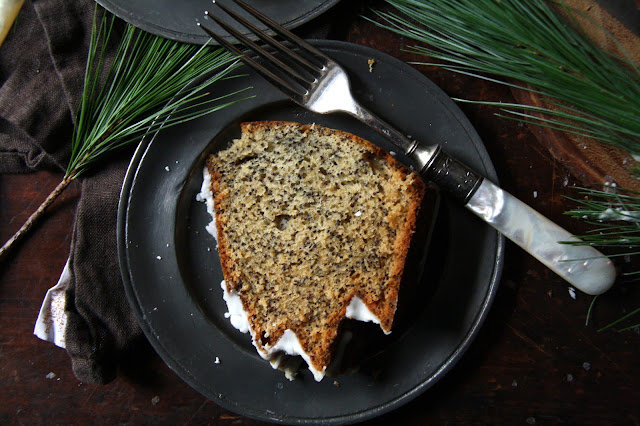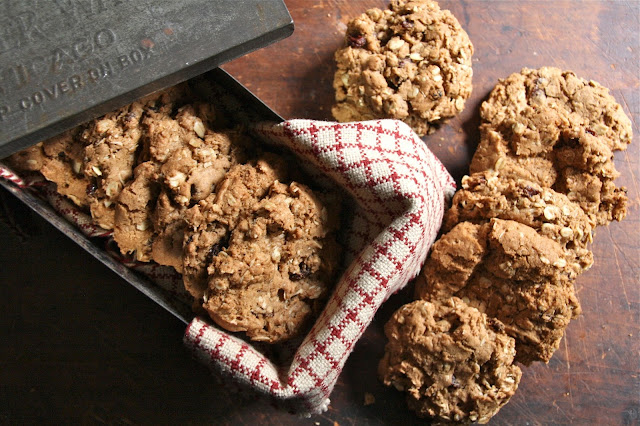While most of my siblings never had any difficulty cleaning our plates, we weren't allowed to leave the table until there wasn't a morsel left on them. 'Eat your vegetables' could be heard with predictable regularity at the kitchen table. My father sometimes pretended to be oblivious to my strategy of spreading mashed potatoes ever so thinly across my plate, almost making them appear invisible. Of course, I believed I was getting way with something.
Almost everything I learned about cooking and baking growing up I learned from my father. From making a white sauce (creamed tuna on toast was one of my favorite lunches), to making a smooth, flavorful gravy (as good as it was it I still couldn't swallow mashed potatoes), to whipping egg whites to stiff peaks and folding them into cakes. In retrospect, this early culinary education had a significant impact on me. Everything was made from scratch when my father was cooking and baking. A Poppy Seed Cake dusted with confectionary sugar was one of his favorites. And because it was his favorite, it was mine too.
In my traveling back in time moment, I seemed to recall the recipe for this cake was on the back of the Solo Poppy Seed Filling can. The packaging of the can for this filling has changed over the years. No longer is the recipe, one with directions beginning with the words 'follow recipe carefully and slowly', printed on the label. Fortunately in a Google search I found a copy of that original label, the one with the recipe for the Poppy Seed Cake. Within a few days of finding this recipe, I was making 'the' Poppy Seed Cake from my childhood. Except instead of a sifted confectionary sugar finish, I decided a confectionary sugar glaze would be its' finishing touch. And rather than use a tube pan with a removable bottom (otherwise known as the Angel Food cake pan in our house), I chose to use a recently purchased gorgeous Nordic Ware pan. Two changes my father would have at least pretended to approve. Being the oldest of four, I believed being the favorite meant I could do no wrong. Although my siblings might have conflicting opinions.
There was a reason the recipe started with the cautionary 'read carefully' words. Unlike many cakes, the eggs are separated. The egg yolks are added into the batter one at a time, while the egg whites are beaten to stiff peaks and folded in to the finished batter.
Like most cakes, the dry ingredients are sifted before they are added to the batter.
Truth: It's easier to separate eggs while they are still cold. However, there are two points of view relative to an egg white's temperature when a recipe calls for them to be beaten. Either beat them cold or beat them at room temperature. Beating egg whites cold produces smaller, tighter bubbles not easily deflated when folded into a batter. The volume of whipped egg whites increases significantly when they are room temperature. However, their larger bubbles slightly reduces the stability of the beaten egg whites. The size and stability of the bubble matters more for some baking applications. For this cake, either option would work. If you have a copper bowl to beat your eggs in, great. But it's not an egg beating deal breaker. Note: My separated egg whites sat out for about an hour before I started baking. They weren't cold and they weren't room temperature, just somewhere in between.
Use a spatula to gently fold the beaten egg whites into the batter.
Having had a few unmolding bundt pan disasters in my baking lifetime, I am extra careful about preparing the pan with vegetable spray and a dusting of flour. Once all of the batter has been spooned into the bundt pan, smooth the top with the back of a spoon or off-set spatula.
The Poppy Seed Cake bakes in a preheated 350 degree (F) oven for 60 to 75 minutes or until a cake tester comes out clean when inserted in the deepest part of the cake. Note: My baking time for this bundt pan was 65 minutes. Once removed the oven the cake pan should be placed on a cooling rack and allowed to rest for 25 minutes before the cake is unmolded. Removing it too early or leaving it in the pan too long could result in an umolding disaster.
To ensure your confectionary sugar glaze is smooth, always sift the confectionary sugar. The amount of liquid (whole milk) used to make this glaze will range from 2 to 4 tablespoons. Three (3) Tablespoons gave me the consistency I wanted. Just remember to add in additional milk 1 Tablespoon at a time. To give the glaze a purer white look, I used a clear vanilla extract.
Wait at least 30 to 45 minutes before spooning glaze over the top of the Poppy Seed Cake.
No matter how old we are, parental approval almost always causes us to feel happy, proud, loved. I wished my father were still here to tell me what he thought of my version of 'his' cake.
A wave of emotions came over me as I took a bite of this Glazed Poppy Seed Cake. The kind simultaneously causing me to be both happy and sad weepy. Making of this cake not only reminded me of my father, but it reaffirmed the power memories can have on maintaining and strengthening the relationships we have with the people in our lives we love, we want to keep close. Life can, at times, be hectic. Giving us reasons or excuses to let it get it in the way of letting memory making opportunities slip away. Remembrances, those photographs forever imprinted in our minds and on our hearts, might well be one of the most endearing gifts we can both give and receive. And, if by chance food is somehow involved, well that would be the proverbial 'icing on the cake'.
And oh yes, this Glazed Poppy Seed Cake was as moist, as dense, as flavorful, and as good as I remembered.
Glazed Poppy Seed Cake (several adaptations to the original recipe printed on the Solo Poppy Seed filling can)
Ingredients
Cake
1 cup unsalted butter, room temperature
1 can (12.5 ounce) Solo Poppy Seed Cake and Pastry Filling
1 1/2 cups granulated sugar
4 large eggs, separated
1 teaspoon vanilla
1 cup sour cream
2 1/2 cups all-purpose flour
1 teaspoon baking soda
1 teaspoon kosher salt
Confectionary Sugar Glaze
1 1/2 cups confectionary sugar, sifted
2 to 4 Tablespoons whole milk
1/2 teaspoon vanilla
Pinch of kosher salt
Optional: Edible glitter flakes to sprinkle over the confectionary glaze.
Directions
Cake
1. Preheat oven to 350 degrees (F).
2. Sift together the flour, baking soda and salt in a medium sized bowl. Set aside.
3. In a standing mixer fitted with a paddle attachment, beat butter and sugar until light and fluffy (approximately 3 to 5 minutes).
4 Mix in the can of Solo poppy seed cake and pastry filling.
5. Add egg yolks, one at a time, beating well after each addition.
6. Mix in sour cream and vanilla.
7. Gradually add sifted flour, baking soda and kosher salt keeping mixer on low and beating until fully incorporated.
8. In a separate bowl, beat egg whites until stiff peaks form, but be careful not to dry out.
9. Fold egg whites into cake batter.
10. Pour batter into a prepared bundt pan or 9-10 inch tube pan.
11. Baking time is 60 to 75 minutes or until a cake tester comes out clean when inserted into the cake.
12. Transfer cake to wire rack and allow to cool for 25 minutes. Note: Baking time may be slightly longer if baked in a tube pan or if cake mold is very deep.
13. Invert and transfer to a cake stand or platter. Allow to cool for at least 30-45 minutes before pouring Confectionary Sugar Glaze over the top.
14. Slice and serve. Store cake tightly covered. Flavor continues to improve on the second day.
Glaze
1. In a medium bowl, combine confectionary sugar, 2 Tablespoons of milk, vanilla and salt. Using either a hand mixer or whisk, blend ingredients until the icing is smooth. If too thick, add milk, 1 Tablespoon at a time.
2. Pour glaze over cake. Allow to set.
Notes: (1) Cake can be made in two 9" cake pan. Reduce baking time to 45 minutes or until done. (2) For a pure white icing use clear vanilla. (3) The flavor of the cake further develops if you make the day/night before serving. (4) Instead of the Confectionary Sugar Glaze, simply dust with confectionary sugar. (5) The original recipe printed on the Solo can called for the use of shortening instead of unsalted butter. (6) This is the perfect cake to serve with coffee or tea, to eat for breakfast, to eat as a snack.




























































